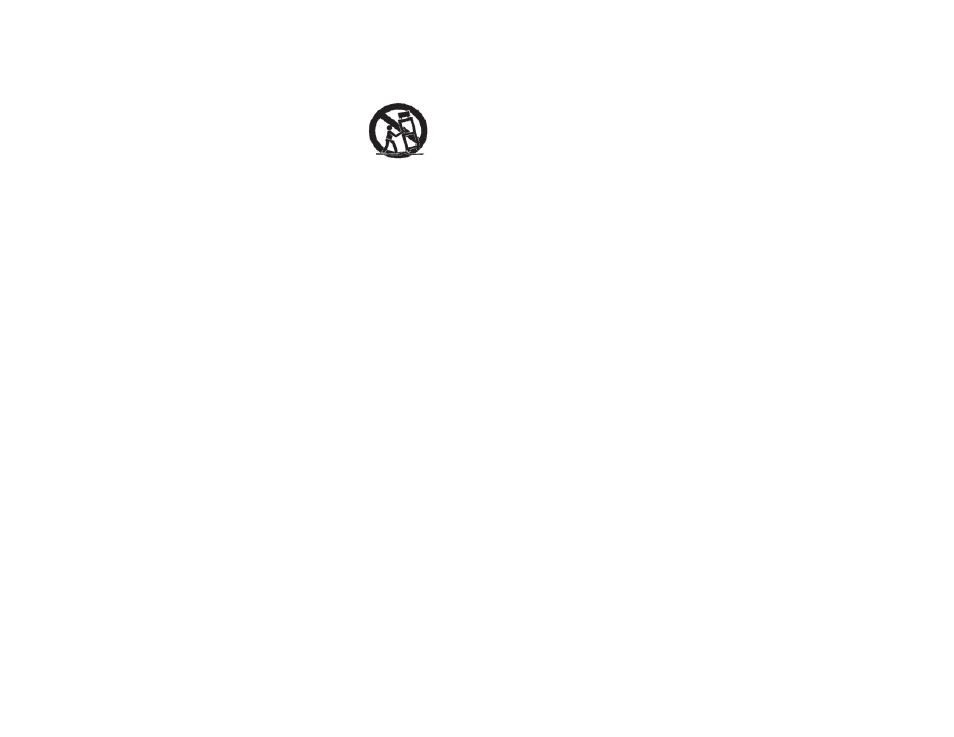EXCALIBUR RD70-OA SoundMaster Classic 5-in-1 Music Center User Manual
Page 9

n Transporting/moving unit: This product should be moved with care
to avoid damage or injury.
n Ventilation: Slots and openings in the cabinet are provided for
ventilation, to ensure reliable operation of the product and to protect it
from overheating. ANY ventilation openings MUST NOT be blocked
or covered in any way, this includes placing the product on a bed, sofa,
rug, or similar surface. Also the 5-in-1 Classic Music Player should not
be placed in a built-in installation such as a bookcase or rack unless
proper ventilation is provided.
n Wall or ceiling mounting: The product should be mounted to a wall
or ceiling only as recommended by the manufacturer.
n Water and moisture: Do NOT use this product near water or any
kind of moisture, this includes–bath tubs, wash bowls, kitchen sinks, or
laundry washers, wet basements, swimming pools, etc.
16
17
n Location and accessories: Do NOT place this product on
an unstable surface. The 5-in-1 Classic Music Player may
tip and fall, causing serious physical injury and serious
damage to the product. Use only with the recommended
stand, bracket, or table from the manufacturer. Any
mounting of the product should follow the manufacturerʼs
instructions, Use only the recommended mounting accessories from the
manufacturer.
n Object and liquid entry: Never push objects of any kind into this
product through openings. Those objects may touch dangerous voltage
parts that could result in a fire or electric shock. NEVER spill liquid of
any kind on the product.
n Overloading electrical circuits: Do NOT overload wall outlets,
extension cords, or any other integral convenience electrical
receptacles. This can result in a risk of fire or electric shock.
n Power-cord protection: All Power-supply cords should be placed and
routed, so that they are not likely to be trapped in any way.
n Power lines: An outside antenna system should not be located in the
vicinity of overhead power lines or other electric light or power
circuits, or where it can fall into such power lines or circuits. If you are
installing an outside antenna system, use extreme care to keep from
touching such power lines as contact with them might be fatal.
n Power sources: This product should be operated only from the type of
power
source
(Specifications Section of this Userʼs Guide, see
page
12.) If you are not sure of the type of power supply to your home,
consult your product dealer or a local power company.
n Replacement parts: When replacement parts are required, be sure that
the service technician has used replacement parts specified by the
manufacturer. Unauthorized substitutions may result in fire, electric
shock, or other hazards.
n Safety check: Upon completion of any service or repairs to this
product, ask the service technician to perform safety checks to
determine that the product is in proper, operating condition.
n Servicing: Do NOT attempt to service this product yourself, it may
expose you to dangerous voltage or other hazards. Refer all servicing
to qualified service personnel.
This device complies with Part 15 of the FCC Rules. Operation is subject to the following
two conditions: (1) this device may not cause harmful interference, and (2) this device must
accept any interference received, including interference that may cause undesired operation.
NOTE: This equipment has been tested and found to comply with the limits for a Class B digital
device, pursuant to Part 15 of the FCC Rules. These limits are designed to provide reasonable l
interference in a residential installation. This equipment generates, uses and can radiate radio
frequency energy and, if not installed and used in accordance with the instructions, may cause
harmful interference to radio communications. However, there is no guarantee that interference
will not occur in a particular installation. If this equipment does cause harmful interference to
radio or television reception, which can be determined by turning the equipment off and on,
the user is encouraged to try to correct the interference by one or more
of the following measures:
• Reorient or relocate the receiving antenna.
• Increase the separation between the equipment and receiver.
• Connect the equipment into an outlet on a circuit different from that to which the
receiver is connected.
• Consult the dealer or an experienced radio/TV technician for help.
